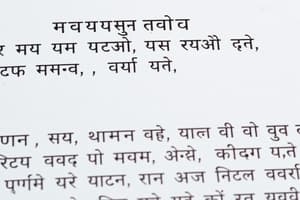Podcast
Questions and Answers
Which script is used to write Assamese?
Which script is used to write Assamese?
- Latin script
- Brahmi script
- Devanagari script
- Assamese script (correct)
What is the primary word order in Assamese syntax?
What is the primary word order in Assamese syntax?
- Subject-Object-Verb (correct)
- Verb-Subject-Object
- Object-Subject-Verb
- Verb-Object-Subject
What role does Assamese play in the cultural identity of its speakers?
What role does Assamese play in the cultural identity of its speakers?
- It is primarily used in technology and science.
- It reflects the culture, traditions, and history of the Assamese people. (correct)
- It is a foreign language learned for business.
- It has no significance in local communities.
Who is a notable author in Assamese literature?
Who is a notable author in Assamese literature?
How many speakers of Assamese are estimated to exist currently?
How many speakers of Assamese are estimated to exist currently?
Flashcards are hidden until you start studying
Study Notes
Language Overview
- Assamese is an Indo-Aryan language primarily spoken in the Assam state of India.
- It is the official language of Assam and serves as a lingua franca for the region.
Linguistic Features
- Script: Written in the Assamese script, which is derived from the Brahmi script.
- Phonetics: Rich in vowels and consonants; features nasalized vowels.
- Dialectal Variations: Numerous dialects exist, including Kamrupi, Goalpariya, and Cachari.
Cultural Significance
- Assamese is integral to Assamese identity; it reflects the culture, traditions, and history of the Assamese people.
- Folk literature, songs, and festivals like Bihu are prominent expressions in Assamese.
Grammar
- Nouns: Gendered (masculine and feminine), with pluralization rules.
- Verbs: Conjugated based on tense, mood, and aspect.
- Syntax: Generally follows Subject-Object-Verb order.
Literature
- Home to a rich literary tradition, including poetry, novels, and plays.
- Notable poets and authors include Lakshminath Bezbaroa, Missionary Gopinath Bordoloi, and Bhabendra Nath Saikia.
Language Policy and Education
- Promoted in schools and colleges across Assam; included in curriculum from primary education onward.
- Efforts to preserve the language through various literary and cultural organizations.
Current Status
- Approximately 15 million speakers as of recent estimates.
- Efforts are ongoing to revitalize and promote the language amidst challenges from globalization and linguistic homogenization.
Key Organizations
- Assamese Sahitya Sabha: A major literary organization promoting Assamese literature and culture.
- Assam Official Language Act: Supports the use and promotion of Assamese in government and education.
Conclusion
- Assamese is more than a means of communication; it is a vital component of cultural heritage and identity in Assam, shaping both local and broader Indian culture.
Language Overview
- Assamese is an Indo-Aryan language spoken primarily in the Assam state of India.
- It is the official language of Assam and serves as a lingua franca for the region.
Linguistic Features
- Written in the Assamese script, which is derived from the Brahmi script.
- Assamese is rich in vowels and consonants, including nasalized vowels.
- Dialectal variations exist, including Kamrupi, Goalpariya, and Cachari.
Cultural Significance
- Assamese is integral to Assamese identity and reflects the culture, traditions, and history of the people.
- Folk literature, songs, and festivals like Bihu are prominent expressions in Assamese.
Grammar
- Assamese nouns are gendered (masculine and feminine) with pluralization rules.
- Verbs are conjugated based on tense, mood, and aspect.
- Syntax generally follows Subject-Object-Verb order.
Literature
- Assamese has a rich literary tradition, including poetry, novels, and plays.
- Lakshminath Bezbaroa, Missionary Gopinath Bordoloi, and Bhabendra Nath Saikia are notable poets and authors.
Language Policy and Education
- Assamese is promoted in schools and colleges across Assam, included in curriculum from primary education onward.
- Literary and cultural organizations are working to preserve the language.
Current Status
- Assamese has approximately 15 million speakers as of recent estimates.
- There are ongoing efforts to revitalize and promote the language amidst challenges from globalization and linguistic homogenization.
Key Organizations
- The Assamese Sahitya Sabha is a major literary organization promoting Assamese literature and culture.
- The Assam Official Language Act supports the use and promotion of Assamese in government and education.
Conclusion
- Assamese is a vital component of cultural heritage and identity in Assam, shaping both local and broader Indian culture.
Studying That Suits You
Use AI to generate personalized quizzes and flashcards to suit your learning preferences.




